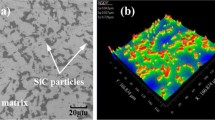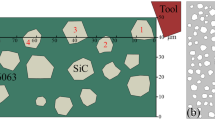Abstract
Machining technology about ceramics has been developed very fast over recent years due to the growing industrial demand of higher machining accuracy and better surface quality of ceramic elements, while the nature of hard and brittle ceramics makes it difficult to acquire damage-free and ultra-smooth surface. Ceramic bulk can be treated as an assemblage of discrete particles bonded together randomly as the micro-structure of ceramics consists of crystal particles and pores, and the inter-granular fracture of the ceramics can be naturally represented by the separation of particles due to breakage of bonds. Discrete element method (DEM) provides a promising approach for constructing an effective model to describe the tool–workpiece interaction and can serve as a predicting simulation tool in analyzing the complicated surface generation mechanism and is employed in this research to simulate the mechanical polishing process of ceramics and surface integrity. In this work, a densely packed particle assembly system of the polycrystalline Si3N4 has been generated using bonded-particle model to represent the ceramic workpiece numerically. The simulation results justify that the common critical depth of cut cannot be used as the effective parameters for evaluating brittle to ductile transformation in ceramic polishing process. Therefore, a generalized criterion of defining the range of ductile regime machining has been developed based on the numerical results. Furthermore, different distribution of pressure chain is observed with different depth of cut which ought to have intense relationship with special structure of ceramics. This study also justified the advantage of DEM model in its capability of revealing the mechanical behaviors of ceramics at micro-scale.











Similar content being viewed by others
References
W. Harrer, R. Danzer, R. Morrel, Influence of surface defects on the biaxial strength of a silicon nitride ceramic—increase of strength by crack healing. J. Eur. Ceram. Soc. 32(1), 27–35 (2012)
A.N. Samant, N.B. Dahotre, Laser machining of structural ceramics—a review. J. Eur. Ceram. Soc. 29(6), 969–993 (2009)
H.D. Vora, S. Santhanakrishnan, S.P. Harimkar, S.K.S. Boetcher, N.B. Dahotre, Evolution of surface topography in one-dimensional laser machining of structural alumina. J. Eur. Ceram. Soc. 32(16), 4205–4218 (2012)
Y. Tan, D. Yang, Y. Sheng, Discrete element method (DEM) modeling of fracture and damage in the machining process of polycrystalline SiC. J. Eur. Ceram. Soc. 29(6), 1029–1037 (2009)
D. Iliescu, D. Gehin, I. Iordanoff, F. Girot, A discrete element method for the simulation of CFRP cutting. Compos. Sci. Technol. 70(1), 73–80 (2010)
V. Kuzin, A model of forming the surface layer of ceramic parts based on silicon nitride in the grinding process. Key Eng. Mater. 496, 127–131 (2011)
T. Pawlik, M. Sopicka-Lizer, J. Wieczorek, The effect of pressureless densification on mechanical and tribological properties of fine-grained silicon nitride ceramics. IOP Conf. Ser. Mater. Sci. Eng. 35, 1–6 (2012)
F.M. Sciammarella, M.J. Matusky, Correlation between mechanical strength and surface conditions of laser assisted machined silicon nitride. Opt. Meas. Model. Metrol. 5, 187–197 (2011)
N. Mishima, S. Kondoh, H. Hyuga, Y. Zhou, K. Hirao, Analysis and quantification of improvement in green manufacturing process of silicon nitride products. Glob. Solut. Sustain. Manuf. 18, 359–364 (2011)
M.K. Satyarthi, P.M. Pandey, Comparison of EDG, diamond grinding and EDM processing of conductive alumina ceramic composite. Mater. Manuf. Process. 28(4), 369–374 (2013)
Y. Lee, Evaluating subsurface damage in optical glasses. J. Eur. Opt. Soc (Rapid Publications) 6, 11001-1–11001-16 (2011)
P.S. Shinde, Modeling and analysis of the grinding parameters. Appl. Mech. Mater. 110–116, 2548–2553 (2012)
J.H. Shin, B. Kumar, J.H. Kim, Tribological properties of Si3N4/SiC nano–nano composite ceramics. J. Am. Ceram. Soc. 94(11), 3682–3685 (2011)
M.M. Reddy, K.A. Abou, Influence of cutting parameters on machinable glass ceramic processed by end milling. Adv. Mater. Res. 264–265, 825–830 (2011)
G. Subhash, R. Bandyo, A new scratch resistance measure for structural ceramics. J. Am. Ceram. Soc. 88(4), 918–925 (2005)
O. Desa, S. Bahadur, Material removal and subsurface damage studies in dry and lubricated single-point scratch tests on alumina and silicon nitride. Wear 225–229, 1264–1275 (1999)
S.H. Frédéric, V. Donzé, I. Daudeville, Discrete element modeling of concrete submitted to dynamic loading at high strain rates. Comput. Struct. 82, 2509–2524 (2004)
P. A. Cundall, A computer model for simulating progressive large scale movements in blocky rock systems. in Proceedings of the Symposium of the International Society for Rock Mechanics, Nancy, France, 1971, vol. 1, pp. 8–17
Y.Q. Tan, D.M. Yang, Y. Sheng, Study of polycrystalline Al2O3 machining cracks using discrete element method. Int. J. Mach. Tools Manuf. 48, 975–982 (2008)
B. An, D.D. Tannant, Discrete element method contact model for dynamic simulation of inelastic rock impact. Comput. Geosci. 33, 513–552 (2007)
C. Thornton, Numerical simulations of deviatoric shear deformation of granular media. Geotechnique 50, 43–53 (2000)
C.Y. Wu, L.Y. Li, C. Thornton, Rebound behavior of spheres for plastic impacts. Int. J. Impact Eng. 28, 929–946 (2003)
G.P. Lian, C. Thornton, M.J. Adams, A theoretical-study of the liquid bridge forces between two rigid spherical bodies. J. Colloid Interface 161, 138–147 (1993)
K.D. Kafui, C. Thornton, M.J. Adams, Discrete particle-continuum fluid modelling of gas solid fluidised beds. Chem. Eng. Sci. 57, 2395–2410 (2002)
I.D. Marinescu, H.K. Tonshoff, Handbook of Ceramic Grinding and Polishing (Noyes Publications, New Jersey, 2000)
G.K. Thimmaiah, A.P. John, P.C. Harish, Numerical simulation of ductile machining of silicon nitride. J. Mech. Eng. Sci. 218(6), 577–582 (2004)
S.K. Ajjarapu, R.R. Fesperman, J.A. Patten, H.P. Cherukuri, Ductile regime machining of silicon nitride: experimental and numerical analyses. AIP Conf. Proc. 712, 1377–1383 (2004)
S.K. Ajjarapu, R.R. Fesperman, J.A. Patten, H.P. Cherukuri, C.J. Brand, Ductile regime machining of silicon nitride: a numerical study using Ducker–Pager material model. Trans. N. Am. Manuf. Res. Inst. SME 32, 519–524 (2004)
T.G. Kumbera, H.P. Cherukuri, J.A. Pattern, C.J. Brand, T.D. Marusich, Numerical simulations of ductile machining of silicon nitride with a cutting tool of defined geometry. Mach. Sci. Technol. 5(3), 341–352 (2001)
J.A. Patten, W. Gao, R. Fesperman, Ductile regime nanocutting of silicon nitride, in Proceedings of the 15th Annual Meeting of the American Society for Precision Engineering, 2000, pp. 106–109
P.S. Sreejith, Machining force studies on ductile machining of silicon nitride. J. Mater. Process. Technol. 169, 414–417 (2005)
Acknowledgments
This work was supported by China Scholarship Council (Grant No. 201208120091) and LPMT of CAEP (Grant No. KF13009).
Author information
Authors and Affiliations
Corresponding author
Rights and permissions
About this article
Cite this article
Han, X. Investigation of the surface generation mechanism of mechanical polishing engineering ceramics using discrete element method. Appl. Phys. A 116, 1729–1739 (2014). https://doi.org/10.1007/s00339-014-8309-3
Received:
Accepted:
Published:
Issue Date:
DOI: https://doi.org/10.1007/s00339-014-8309-3




